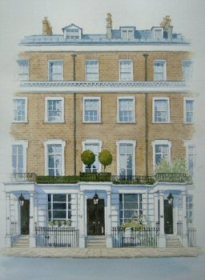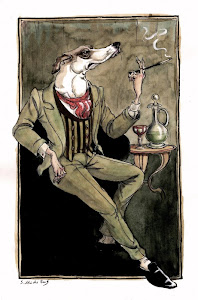Kentucky Fried Georgian
Alexandra Artley and John Martin Robinson
The Spectator, 22 December 1984
Conservation fogeys love expressing opinions. They bang on about COUNTY BOUNDARIES ('they can call Yorkshire what they like. I come from the NORTH RIDING and PROUD of it'); ABOLITION OF TELEGRAMS ('I shall write to the Post-Master General'); OPEN-PLAN TRAINS ('the crack of ring- pull cans was DEAFENING!'); CEN-TRAL HEATING ('don't beso FEEBLE. It will split your mahogany'); FITTED CARPETS IN CHURCHES
(`absolutely OUTRAGEOUS'); BUILDINGS BY AGEING MODERNISTS ('meretricious TAT'); MODERN RC CHURCH ('Father Banjo 0' Marx'); THE ANGLICAN CHURCH
('Runcie-balls'); BRITISH TELECOM ('TeIeCON more like'); HABITAT ('ha-ha-ha'); THE NATION-AL GALLERY ('a national DISGRACE'); NOUVELLE
CUISINE ('had to eat a CHEESE SANDWICH on the way home'); MICROWAVE OVENS (laughter in the house); Then, plop, the Spectator falls through the letterbox and Mr Fogey sits in COMPLETE SILENCE and reads it.
The flashing synapses of high-powered fogey brains burn food. Conservation fogeys are the world's greatest diners out. They have developed the art of eating huge amounts while campaigning, SAVE-ing and talking non-stop most convivially.
`And now Silent Night arranged by Stock-'
THOSE OPINIONS boom out while roast beef, boiled potatoes, cabbage anglaise, yummy, proper gravy in a hot boat, rice pudding with skin, or failing that, crème brulee, fly down the fogey throat. With dinner they like little Knoxian jokes ('Do you take this margarine for butter or worse?).
In winter, conservation fogeys often dine in Spitalfields, home of the new Baroque. At nine, through the dark of the decayed vegetable market they come in Suits, tweeds, grey wool scarves in plain but not purl, thick corduroy trousers from the Bedford Riding Breeches Company, macs and chestnutty brogues dull with dubbing. In the high art gloom, groups of derelicts brawl with bottles round wild fires
(very Joseph Wright of Derby). Fire and gloom play a large part in the fogey temperament. When a fogey is invited to dinner he arrives with wooden crates pulled off a skip to fuel his host's huge hearths. Fires in fogey dining rooms are so fierce that Mrs Fogeys often get burn marks between their shoulder blades from molten bra hooks.
Dinner in Spitalfields is a very chiaros-curo matter. Fogeys like dancing shadows in panelled rooms and the smell of roast meat or Brick Lane Indian take-aways wafting up from the basement. Then there is more talk, campaigning, new strategies, DISGRACEFUL, large whiskies, bashed silver candle-sticks, strong beeswax candles bought by the pound from church suppliers, eye-to-eye contact with canvas instant ancestors, chipped cream-ware, dripping-wax sconces on the walls and the bong of bones dropped on threadbare rugs for seething animals. In the candlelight long fogey arms whip out for the eye- watering English mustard. At three in the morning there are several feet of restless ash in the hearth and a slim chance of taxis from Bishopsgate to other fogey haunts. Last comes the lost cord: at night bachelor fogeys stride home to thick striped pyjamas.
Conservation fogeys bounced off Sixties' property spivs and stack-a-prole planners. They are the first English generation since the Thirties (Robert Byron and friends) to be visually literate and to feel sorry for down-and-out things as well as people. The two are often connected. Buildings are pulled down and their vulnerable inhabitants moved on. Keeping philistines routed is quite time-consuming. Consequently, Mr Fogey consults a huge half-hunter worn on a watch chain and warmed by his chest. He never wears anything on his wrist (it stops him speaking off the cuff) but he likes plenty of clocks at home (boing, boing' boing). Other accessories include an old, very heavy bicycle for racing to conservation meetings. Sometimes, when cycling, he wears a pair of Thirties' leather motoring goggles. Fogeys cycle with an upright Edwardian
posture and hang out like yachtsmen round Hyde Park. When Mrs Fogey sees this from a bus her heart gives a horrid leap.
The conservation fogey is an urban chevalier and his bicycle is his horse. He loves and understands the British city. When he is not cycling he walks long and purposefully across it like Dickens. The most time-consuming thing in Mr Fogey's life, apart from campaigning, is a house, or when he is a poor Very Young Fogey, a basement or garret flat in the right sort of house. Fogeys differ from young Sloanes in the way they look at London property. Sloanes choose the area they want to live in and then find a house. Fogeys find the perfect house to restore and don't give a damn about the area. They go where the architecture is and this is usually the rotting Georgian centres of big cities. Fogeys like Places to be socially crunchy. This means a healthy mix of young, old, crims (criminals), Bangladeshis, clergy and council Estaters. Whereas Sloanes treat everyone in a jolly way, they like to maintain class difference where they live because it feels safer. Conservation fogeys give the impression of being fierce, but they live in Socially mixed areas because they like the Individualism of different types of people. In grand circles this
used to be called feudal familiarity. Mr and Mrs Fogey like to live in decaying splendour with wonderful, slightly broken things. They love costly tatters, the aristocratic aesthetic of pleasing decay. Their walls of patchy bare plaster give the Crumbling Palazzo Look. It is like hanging pictures on the inside of a Stilton. To go With that they like old china repaired with brass rivets. (If they find a pretty mug in Woolworths, really mad fogeys break it and get it repaired by a pro. Then it looks very interesting.) All fogeys love pink lustre china (sweet disorder on a shelf), English cream-ware and grisaille pieces. scigey cats are encouraged to shred bits of silk to make them look like the cushions at Sissinghurst. For special occasions like weddings, christenings, house birthdays (250 YEARS OLD TODAY) or ordinary human
birthdays, Mrs Fogey sits down at the kitchen table to splosh out pink lustre greetings cards with pinky-bronze ink. Meanwhile, Mr Fogey keeps obelisk culture alive. Obelisks mean I REPRESENT CLASSICISM, visual literacy, proportion
In all things, restraint, the vanity of human wishes, and fogeys like them a
lot. China obelisks are very expensive so fogeys make temporary ones from
marblised paper, varnish them and letter them with the Roman numerals and
greetings (A NUPTIAL OBELISK, A BIRTHDAY OBELISK, ANOTHER OBELISK). This is
clone on the theory of decoy obelisks — the cardboard ones might attract the real
ones in due course.
To repair their houses properly, fogeys invented architectural salvage. Miles away when
philistines are gutting an old house, fogeys pick up high-frequency distress
signals. Suddenly, they are there, saving the bits if they can't actually
stop the destruction. Cracked marble fireplaces, panelled doors masked by
crude hardboard flushing, sash windows, shutters, Carron grates and strangely
brilliant old glass are mourned over and carried home. Another good building
RIP. When a demolition pickaxe shatters the work of the human hand, fogeys feel
it is a blow against humanity. If an old house is modernised with a new
crudely-panelled front door, fogeys call the style Kentucky Fried Georgian.
The streets where fogeys live swirl Fogey superloo in the shape of an obelisk. [...] with greasy boxes
anyway. Like playing with Leggo they swop building bits (one small Georgian
reeded marble fireplace broken in three places equals a big cast- iron bath on
claw feet).
To keep in touch
with world fogeyism Mr Fogey hunts down big black telephones; heavy square
bakelite ones which do not move when his fingers are doing the walking. Fogeys
letter them with the romantic names of old London telephone exchanges (EUSton,
portal of the North, MUSeum, heart of Bloomsbury). Consequently, drunken
guests have difficulty getting taxis late at night. Radio Cabs says, `What is
your number?' Drunken guest says, `TERminus 2020'. The taxi never arrives and
the guest slumps to the floor to be covered with blankets by Mrs Fogey.
Thomas Hope
furniture springs eternal in the fogey breast and here fogey couples mildly
disagree. Mr Fogey is a purist and he likes formal (that means rather hard)
chairs and sofas while Mrs Fogey prefers squashy hippos in washed-out chintz.
All over Bloomsbury the frilly hippos slowly emigrate upstairs. In
Spitalfields, home of the guttering candle, fogey couples argue about light
"bulbs. Mr Fogey screws in 25-watters to maintain the Baroque gloom. After
four o'clock on a winter's afternoon, this means Mrs Fogey needs a torch to
fasten the tabs on her baby fogelet's Pampers.
England is a very
masculine country and conservation fogeys have rather masculine views. (A woman
is a — you know funny sort of CHAP who steadies the bottom end of a ladder.) Fogey
couples often meet at a SAVE lunch, on the first Friday in the month. They are
drawn to each other, the lovely meat-paste sandwiches and grim photographs of
a threatened factory in Bradford in the polychrome Egyptian style. Together
they vow to save it. Fogey courtships take place on coach trips (`the chara')
to see such things as glass cases of rotting taxidermy at Calke Abbey. The
fogey lovers sit at the back of the bus and share a Buildings of England. The
first sign of love is when Mr Fogey offers her a swig from his hip flask and
says to her, 'Listen, WOMAN, your views are quite APPALLING'. The honey- moon
must be somewhere architectural and is usually Rome, in a hotel five feet from
the Pantheon. Rome is so wonderful, the fogey-weds think they have been dropped head first into a box of chocolates. The honeymoon photographs rarely have
Mr Fogey in them because he uses his bride to get scale into architectural
photographs.
Back home Mrs
Fogey wears a droopy skirt, three long sweaters and free-range ear-rings as she
runs lightly through the conservation area. Quickly she learns that trying to
ripen an avocado pear in front of a gas fire is useless. For years she saves
the lead cappings from bottles of wine in case they can be melted down to repair
the roof flashings. From good Spanish bottles she keeps the gold nets to make a
little Rioja snood.
Fogey families
believe in conservation heroics. They live with no roof, then no floors, then
only a few walls, but lots of dry rot, Greek builders drinking Coca-Cola,
collapsing ceilings, cold water, layers of filth, cellars full of old tights
and tea- leaves, re-wiring by day, re-plumbing by fly-by-night and donating the
drawing room as an emergency campaign office. Fogeys learned to rough it in the
early Seventies. They trained as conservation commandos in squats and Direct
Action against London's rapacious property developers. On any given evening,
according to how the architectural battle is raging outside, Mrs Fogey can
expect none or 14 people for dinner. Consequently, she depends on the
flexibility of cottage pie and semolina. Down the stairs to stuttering candles
and soggy cabbage the convivial fogeys come: large whiskies, the smell of
outdoors, DISGRACEFUL, clomp, clomp go the brogues, GRADE II I THINK. Keeping
the best of the past is one way forward and fogey-land dines again.
14 November 2014
Subscribe to:
Post Comments (Atom)





















3 comments:
As a compliment to this blog entry I might suggest that one see the dinner scene during the siege of the British outpost in the movie
"Carry On Up The Khyber".
Basically it's the video for what you have written here and seeing the woga going going batty adds an additional touch of mirth to this already funny scene. In fact see it here:
http://www.youtube.com/watch?v=i8atKXFZefA
The whole clip is really related to this post but the dinner scene starts at 3:15.
All these shabbily gentil characters sound like escapees from the satirical novel Cold Comfort Farm by Stella Gibbons.
I think they're after digging their way out of the 1982 Sloane Ranger Handbook.
Post a Comment